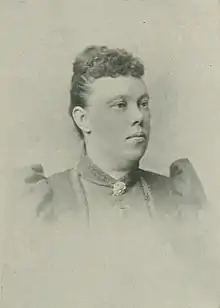
Mellona Moulton Butterfield (May 15, 1853 – 1924) was an American china painter and teacher. The owner of her own kiln for the firing of china, it may have been the first china kiln in Nebraska.[1]
Early years and education
Mellona ("Mellie"[2]) Moulton Butterfield was born in Racine, Wisconsin, May 15, 1853.[3] Her parents were Moses B. Butterfield, a lawyer of Homer, New York, and Mellona (Moulton) Butterfield (1806-1854) of Oxford, Massachusetts. There were two siblings, Emily and Fannie, who, like Mellona, became teachers.[4]
Butterfield was educated in St. Louis, Missouri, and Omaha, Nebraska, and was a graduate of Brownell Hall in Omaha.[3]
Career
She was for twelve years engaged in teaching, which vocation she followed with success in Plattsmouth, Grand Island, and Hastings, Nebraska. During those years, she followed, as devotedly as circumstances would allow, the one art toward which her talents and inclinations tended. At last she gave up other work and applied herself exclusively to ceramic painting, establishing a studio in Omaha. She was one of the first artists in that line in the State of Nebraska. She received many favorable notices from art critics and the press.[3] Her studio was located at 894 Brandeis Building, in Omaha.[5]
She married Charles H. Healey in 1881. She received the first honorable mention for china-painting in the woman's department of the 1884 New Orleans World's Fair, and in 1889, the first gold medal for china-painting given by the Western Art Association in Omaha.[3] The Nebraska Ceramic Club was organized in 1893 for the purpose of making an exhibit at the World's Columbian Exposition.[6] By 1898, it was composed wholly of women, totaling nearly one hundred, with Butterfield as its president.[7] At the 1898 World's Fair, Butterfield supervised the decorating of the Nebraska State Building,[8] and served as the building's hostess.[9] In the following year, she managed the Public Comfort Building.[10] Her work was exhibited in New York City, St. Louis, and Buffalo, New York.[1]
She died in 1924.
References
- 1 2 Bucklin 1932, p. 19.
- ↑ Cooke 1905, p. 400.
- 1 2 3 4 Willard & Livermore 1893, p. 143.
- ↑ Moulton 1906, p. 162.
- ↑ Leonard & Robineau 1907, p. 212.
- ↑ Ceramic Monthly Publishing Company 1895, p. 8.
- ↑ Brigham 1896, p. 271.
- ↑ Katz 2018, p. 116.
- ↑ Katz 2018, p. 132.
- ↑ Katz 2018, p. 159.
Attribution
 This article incorporates text from this source, which is in the public domain: Brigham, Johnson (1896). The Midland Monthly. Vol. 5 (Public domain ed.). Johnson Brigham.
This article incorporates text from this source, which is in the public domain: Brigham, Johnson (1896). The Midland Monthly. Vol. 5 (Public domain ed.). Johnson Brigham. This article incorporates text from this source, which is in the public domain: Ceramic Monthly Publishing Company (1895). The Ceramic Monthly. Vol. 1 (Public domain ed.). Chicago: Ceramic Monthly Publishing Company.
This article incorporates text from this source, which is in the public domain: Ceramic Monthly Publishing Company (1895). The Ceramic Monthly. Vol. 1 (Public domain ed.). Chicago: Ceramic Monthly Publishing Company. This article incorporates text from this source, which is in the public domain: Cooke, R.G. (1905). Casual Essays of the Sun (Public domain ed.). R.G. Cooke.
This article incorporates text from this source, which is in the public domain: Cooke, R.G. (1905). Casual Essays of the Sun (Public domain ed.). R.G. Cooke. This article incorporates text from this source, which is in the public domain: Leonard, Anna B.; Robineau, Adelaide Alsop- (1907). Keramic Studio. Vol. 9 (Public domain ed.). Keramic Studio Publishing Company.
This article incorporates text from this source, which is in the public domain: Leonard, Anna B.; Robineau, Adelaide Alsop- (1907). Keramic Studio. Vol. 9 (Public domain ed.). Keramic Studio Publishing Company. This article incorporates text from this source, which is in the public domain: Moulton, Henry William (1906). Moulton Annals (Public domain ed.). Edward A. Claypool. p. 162.
This article incorporates text from this source, which is in the public domain: Moulton, Henry William (1906). Moulton Annals (Public domain ed.). Edward A. Claypool. p. 162. This article incorporates text from this source, which is in the public domain: Willard, Frances Elizabeth; Livermore, Mary Ashton Rice (1893). A Woman of the Century: Fourteen Hundred-seventy Biographical Sketches Accompanied by Portraits of Leading American Women in All Walks of Life (Public domain ed.). Moulton. p. 143.
This article incorporates text from this source, which is in the public domain: Willard, Frances Elizabeth; Livermore, Mary Ashton Rice (1893). A Woman of the Century: Fourteen Hundred-seventy Biographical Sketches Accompanied by Portraits of Leading American Women in All Walks of Life (Public domain ed.). Moulton. p. 143.
Bibliography
- Bucklin, Clarissa (1932). Nebraska Art and Artists. School of Fine Arts, The University of Nebraska.
- Katz, Wendy Jean (February 2018). The Trans-Mississippi and International Expositions of 1898–1899: Art, Anthropology, and Popular Culture at the Fin de Siècle. U of Nebraska Press. ISBN 978-0-8032-7880-6.